2020 Nest Cam News
This year the pair produced three young! They were banded for future tracking with red aux. bands in late June.
September 17
 An adult osprey perched atop a sailboat in the harbor this morning.
An adult osprey perched atop a sailboat in the harbor this morning.
Well, we've had the great pleasure of having two young remain here long after they could have dispersed and started their migration south. 04 was last observed was on Sept. 13 and 05 on Sept. 14. The male was also last seen on the morning of the 14, when he dropped one last fish for 05. The day they left was after a cold front passed through the area which brought cool north winds and the sign for their migration to begin.
No birds were observed on the nest since, though today, an osprey was perched on a sailboat mast in the harbor to the west of the cam. Hard to know if that is our male. Twist, our volunteer camera operator, has been doing a fantastic job with panning and zooming the cam to follow the action these past couple weeks. He's also helped dial in the camera (and audio!) for a more pleasing viewing experience. We only wish we had Twist on board at the start of the season, but are grateful for his time. Now we can look forward to some neat winter sightings via the cam and already can't wait for the 2021 season to start.
If we get any re-sightings of past BL OSPR CAM alumni then we'll be sure to let you know!
August 26
 Two fledglings perched on the nest. They still rely on the adults for food. Soon they will disperse and begin migration south.
Two fledglings perched on the nest. They still rely on the adults for food. Soon they will disperse and begin migration south.
More than likely the adult female has begun her migration south to her wintering areas. Mid-late August is when adult females begin their journey south. They leave first and are followed by their offspring and then adult males. A theory is that they migrate first to avoid any interference with tropical storms, which could throw them way off course and possibly over open water, where they will not survive.
In other news, the male has been doing a stellar job of capturing prey for 04/M & 05/M. 03/M might be around somewhere, but he is often not seen on the nest much. He is likely able to catch his own prey and is not reliant on the adults anymore, unlike the two females. Early this morning the male delivered a fish to the nest and was grabbed beneath his right eye by one of the fledglings. At first it looked like an intruder came in to steal prey from the fledgling. An act of aggression like this from a fledgling to their own parent has never been witnessed by myself. That's why I thought it was one bird attempting to steal prey from another (called kleptoparasitism). After watching the video frame by frame, we can see the whole fish get dropped during the encounter. A really odd incident to unfold. It's hard to say if the male sustained any injuries to his eye. He has delivered prey since then, so apparently he is okay.. We hope to get a good look at him, but he isn't spending much time on the nest.
August 13
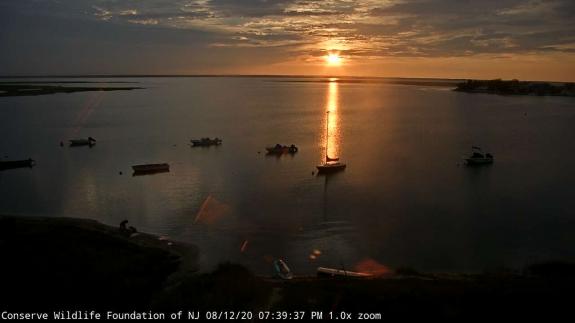 Sunset view from the Osprey Cam on August 12, 2020.
Sunset view from the Osprey Cam on August 12, 2020.
We've been treated to some great views of the area around the osprey nest lately. As the young are becoming more agile on the wing they are less dependent on the nest to rest and feed. They can now be found perched atop local utility poles, sailboat masts, the camera mount, and smaller boats moored in the cove to the west of the nest. It's gettiing to be the time of year when the young disperse and aren't in view of the camera anymore. Soon the female will begin her epic journey to her wintering grounds. Last year the female was gone by the third week in August. We've seen her fattening up with plentiful catches of large bluefish to feed her and her young.
This fall we are planning some simple upgrades to the camera system, which we built and installed. We will be removing the camera and mount to relocate the microphone to a lower location beneath the nest box (where it can be shielded better from wind noise). For this to happen we need the aluminum mount pole to be modified, so our wiring will need to be removed and reinstalled. When we reattach the camera then we will mount it a little lower on the pole, so that we get a little more of an eye level perspective - something that we planned for, but did not have power to view the camera when installing it. Lastly, we will brace the camera mount pole to the nestbox so that camera sway is minimized. After all upgrades are done, then we will re-install the camera for winter viewing.
July 29
On July 26 at 9:22am 04/M fledged and on July 27 at 9:21am 05/M fledged!
July 21
Fledge day is here! 03/M the oldest of the brood fledged this morning at 9:29am. He (we can tell he is a male because of the fit of his bands and the lack of brown feathers on his breast) had some strong hops with short flights directly over the nest yesterday and took flight today. Given that he is the oldeest and a male, it is no surprise to see him fledge first. He hasn't been on camera too much, given his new freedom to explore. The other two nestlings 04/M & 05/M should fledge any day. Females are larger and usually take longer for their flight feathers to fully develop. Now that the young are starting to fledge, the female will be off the nest more and she will forage for herself. She needs to build up some fat reserves before starting her southbound journey to N. South America in August.
July 15
 In the evening on June 30, Ben Wurst visited the BL Osprey Cam nest to band all three young for future tracking!
In the evening on June 30, Ben Wurst visited the BL Osprey Cam nest to band all three young for future tracking!
Things have been quiet at the nest over the past two weeks, which is great. All three were banded on June 30 with both federal USGS aluminum and state aux. red bands (03/M, 04/M, 05/M) for future tracking. The red bands are the least expensive and intrusive way to follow and learn about them throughout their lives. Since we started banding young ospreys with red aux. bands produced at nests on Barnegat Bay, close to 450 young have been banded as part of Project RedBand. This year a total of 22 red banded ospreys from Barnegat Bay have been re-sighted!! Most of those re-sightings have been here in New Jersey and several are birds who have returned here to nest as adults.
As many of you are aware, this is the peak of the osprey nesting season in New Jersey. Most nests contain young and many have young that are close to fledging, at around 7-8 weeks old. The young at this nest are now 6-7 weeks old and should start to fledge in another week. We are now seeing them self feed, which is great. This gives young birds a chance to gain experience gripping a fish and tearing apart flesh and the female a much needed break.
Late last week we had our first named tropical storm impact the area, which was very early for this time of year. With gusty winds and heavy rain, many ospreys had to lay low. Luckily the winds were not too severe to cause any widespread nest failures. So far we have observed mixed results for ospreys throughout the Atlantic coast. There have been some islolated nest failures where groups of nest platforms were completely empty and devoid of any young, and then we had nests overflowing with broods of 2-3 young at every nest. It's a bit of a mystery at this point what might have caused some nests to fail as it could have been predators like eagles or the effects of high winds. Overall, productivity still seems good and enough to sustain the population.
June 30
 The adult female and three young on their nest this afternoon.
The adult female and three young on their nest this afternoon.
Banding day is here! Today CWF Habitat Program Manager Ben Wurst will be visiting the BL Osprey Cam nest to band all three young for future tracking. They are around 4-5 weeks old and at the perfect age for banding. When accessing a nest for banding, the adults fly off the nest and circle and call to defend their nest. The young lay down to "play dead." We try to minimize our time at nests by being well prepared (prepping bands) and will leave some fresh fish for the adults to feed themselves and young afterwards. These young will get both a silver USGS aluminum band and a red aluminum aux. band. The red band will allow us to be able to learn more about these birds while they are still alive! This year we have received re-sightings of 18! live red banded ospreys in NJ!
We are not sure about doing a separate live video of the banding this year, because Ben will be by himself in the bucket and sometimes it is hard to concentrate on banding when also going live. As always you can simply watch the live stream on YouTube or above. Ben will likely take some video from his perspective of the banding to share afterwards and with photos of the young ospreys.
If you live on the island or are visiting, you are welcome to come by to talk to Ben afterwards! The nest is at the west side of 24th St. in Barnegat Light.
June 18
 A busy morning of preening those growing body and flight feathers!
A busy morning of preening those growing body and flight feathers!
I feel like I say this every year -- time flies! The young are growing quickly and are now around 21 days old. This is when their body feathers are emerging from pin and they eat about half their body weight every day. They move around the nest more and are more aware of things outside of the nest.
The male is foraging more often to feed himself, his mate and his brood of three. So far it seems as though he is having no problem finding prey even during times when we have had constant NE winds. I often speculate that nests here in coastal NJ have no problem finding prey because we have both protected estuaries with shallow areas and also open ocean to forage.
In other news - I banded the first osprey nestlings of the season yesterday at Island Beach State Park. They are a little older than these nestlings and around 3.5-4 weeks old. You can watch them via the Pete McLain Osprey Cam hosted by the Friends of Island Beach State Park. Next week we will begin our surveys of osprey nests throughout Barnegat Bay to determine how the colony as a whole is doing. Our volunteers will be doing their own surveys to determine the outcome of ospreys in other major nesting colonies throughout the state. Others are reporting nest outcomes on Osprey Watch, which is where you can view all known osprey nests in NJ.
We will be banding these young during the last week of June or first week of July and will stream it live on our YouTube channel like last year.
June 2
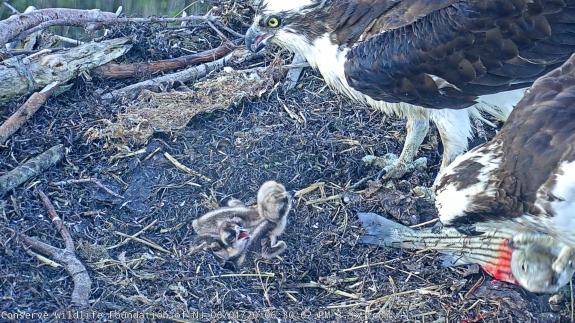 Three hatchlings and a big striped bass!
Three hatchlings and a big striped bass!
We have three! The first egg hatched late in the afternoon on May 28 and then the second hatched early on May 30. Then the third finally hatched early on June 1. This is the first time that this pair (who have nested here since 2018) produced three young!
May 22
 Day 32 of incubation. More of the same. Watching and waiting.
Day 32 of incubation. More of the same. Watching and waiting.
Can't believe it's been so long since my last update here! Time really does fly!! Today marks day 32 of incubation of the first egg. Since this pair has been on the same exact schedule as last year with laying eggs, I wouldn't be the least bit surprised about hatching that coincides with 2019 dates. We saw a pip in the first egg on May 28 and the first feeding on May 29, day 38. Incubation of 40 days is about average for nests that are closest to the ocean. Hard to do a hatching contest with these birds! :)
In other news, so far we have gotten 36 responses to our prey research form. The majority have observed the male returning with menhaden (44.4%) and flounder (27.8%). No surprises there. Thanks to everyone who has conttributed so far. Foraging will really kick into high gear for the male once the eggs hatch. Then the survival of their brood will be determined by his ability to find and catch prey. Luckily he is a veteran at 14 years old, so he knows all the best foraging grounds.
May 1
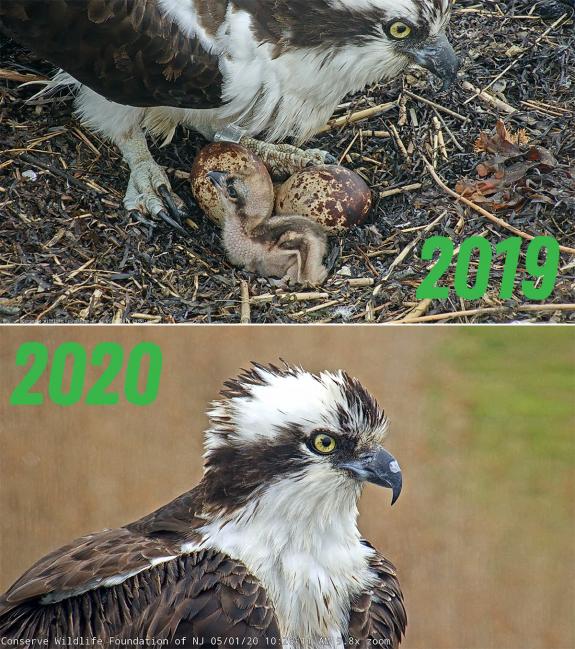 Comparison of male from 2019 to 2020. He's back!!!
Comparison of male from 2019 to 2020. He's back!!!
Today a viewer commented on YouTube about the perch. That prompted me to zoom in to showcase it when the male was perched. I instantly saw his band and did a double take. It read 788, not 1088. This meant one thing - that our old (soon to be 14 years old) male is alive! I looked back at video over the past few weeks and saw that he's been here for the past two weeks - hiding in plain sight! With such poor weather and not as much time to zoom in for a good view, we've missed closeups to positively ID him during this time. Plus, both birds were banded on their left leg with a USGS bird band, so it was honestly something that could easily be missed if not looking close enough to tell the difference. My post on April 24 with the photo of the male I assumed it was the new male, but when you look close you can just barely read 490, so that is our 14 year old - 788-49033!
Now the question is, did the younger 5 year old mate with the female and if so, did he fertilize her eggs? Possibly. It is hard to say for sure, but from when we looked back at the recorded video, the old male returned around April 12 and the first egg was laid on April 20. From Alan Poole's, Ospreys: A Natural and Unnatural History, "Pairs mate most frequently just prior to egg laying. Earlier copulations may actually have little to do with fertilization, serving instead to test a mate's receptiveness (strengthen pair bond)." So it sounds like the young male was just playing around and attempting to court with this female, but the resident male returned just in time to fertilize her eggs.
 A question about the perch led me to zoom in on it. What did I find, the band number of the 2018-2019 male!!
A question about the perch led me to zoom in on it. What did I find, the band number of the 2018-2019 male!!
Either way, this is fascinating behavior to witness because of this camera. This likely happens at other nests where resident birds arrive late on spring migration. Thankfully, this old, experienced male is back and has a brood of three eggs to help incubate!
April 27
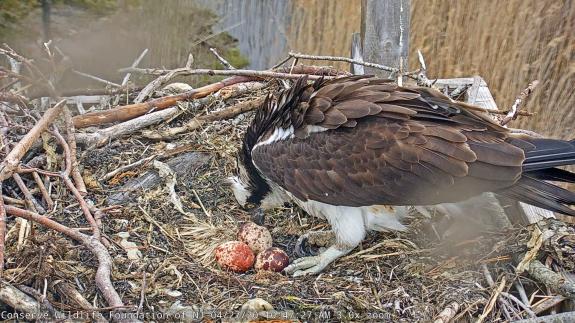 Early on April 26, osprey cam viewer Michelle B. reported that she saw three eggs ~ 3:47am! Pictured is the full clutch, today April 27 with the female. The newest egg is lighter in color than the others.
Early on April 26, osprey cam viewer Michelle B. reported that she saw three eggs ~ 3:47am! Pictured is the full clutch, today April 27 with the female. The newest egg is lighter in color than the others.
Then there were three! Throughout New Jersey most ospreys are now incubating eggs. The onset of incubation can be determined by the presence of birds sitting on the nest 24/7. A low posture, with a flat back, indicates that they're incubating. As we can see by simply watching this camera, the female does the majority of incubation, while the male does 100% of the foraging. Therefore, the success in their reproduction lies with his ability to find and catch prey to feed himself and his mate. The female will get breaks from incubating to stretch her wings, preen, and feed. I find it really intriguing that they usually do not feed on the nest until they have young. This is likely to avoid attracting would-be predators, like crows, gulls, and raccoons to their nest and unhatched eggs.
Since we're right on schedule with 2019, having a contest to guess when the eggs might hatch would be too easy... :)
April 24
 This is our 14 year old male who has nested here since 2018 with a large summer flounder on April 23, 2020. Stephanie Harvey
This is our 14 year old male who has nested here since 2018 with a large summer flounder on April 23, 2020. Stephanie Harvey
As mentioned in a previous entry (4/18), we are contributing to research by a college student who is gathering data from osprey nest cams throughout the world on osprey prey and their productivity. The research will be published as a manuscript in the Journal of Raptor Research. Currently there are four countries and 13 cameras (including ours) who are participating. The goal of the research, as stated by the student, is "to report fish counts and species, and nesting success gathered from citizen science and nest cam data. My aim is to establish citizen science and nest cameras as valid and substantial tools for the scientific and educational communities. Thus, enhancing our knowledge."
Here we know what the main prey items are (flounder and menhaden), but we do not offically record them. Contributing to this project will be a great way to document what prey are delivered, how often and how successful they are in producing young that fledge. It will also help engage more people in watching the cam and learning about the life cycle of ospreys. Anyone can contribute by watching the live stream or locally from the gound, like Stephanie H. who got a great shot of the male with a large summer flounder!
To access the form, click here (we will also make a widget on the sidebar so you can access it from there).
April 23
 The second egg was visible early this morning. So far this female is laying like clockwork - a couple hours earlier, but on the exact same days as last year! Egg three should come on 4/26.
The second egg was visible early this morning. So far this female is laying like clockwork - a couple hours earlier, but on the exact same days as last year! Egg three should come on 4/26.
Right on schedule! Egg two was laid sometime early this morning (will look to confirm time from recorded video). Viewer Michelle B. reported seeing two eggs around 5:10am. Egg three should drop on 4/26.
April 20
This morning the female laid the first of at least three eggs! Right after 8:00am she stood and showed the glossy, fresh laid egg. So far today she has been glued to the egg, but got a chance to feed around 1:30pm, then the male took over incubating. Females do around 70% of nest duties, including incubating and males do 100% of the foraging. They start incubating after they lay the first egg, so an adult will always be on the nest from now until they all hatch.
The amazing part is that she laid the egg today one year from when she laid the first egg last year! If she keeps on the same schedule then we should see egg 2 on 4/23 and 3 on 4/26. If they incubate for the same number of days (38 days) then the first egg should pip and hatch on 5/28.
If you want to read updates from last year, then check out our archived 2019 NestCam News.
April 18
I like to think that this site is being more and more desirable to ospreys, as we continually see more competition for the nest. Generally speaking, this is becoming more and more common, as there are more ospreys who are living longer and seeking to takeover estabished nests. Not far from this nest platform, which sat unused for more than a decade after being installed by the Garden Club of LBI, there is another unused tall nest platform. This spring we heard from locals that ospreys have been seen perched on it and even adding nesting material. Hopefully we see some birds settle down to nest on that platform as well, since there aren't too many available nest sites on the 18 mile long barrier island. Most nests are located on the many channel markers, islands, and back bay saltmarshes.
Viewers yesterday notified us that a red banded osprey, 65/D, who looks like a female (by the fit of her leg bands) attempted to land on the nest around 12:52pm on April 17. 65/D is one of 400 ospreys who originated from nests on Barnegat Bay and were banded as a nestling as part of Project RedBand, our osprey re-sighting project. She was banded at a nest near the south end of LBI on Marshelder Island on June 26, 2017. This is the first time that she has been re-sighted. If you see a red banded bird, please let me know!
In other news, this year we are helping a researcher look into the prey of ospreys by using observations collected from live streaming cameras at nests. "The goal is to report fish counts and species, and nesting success gathered from citizen science and nest cam data. My aim is to establish citizen science and nest cameras as valid and substantial tools for the scientific and educational communities. Thus, enhancing our knowledge."
The data that we will collect includes:
- Date
- Fish data (how many and fish species, if possible)
- Breeding Success or Failure
We will create a form (linked to from this page and the live stream on YouTube) where viewers can submit reports of fish caught and consumed at the nest. Stay tuned for more information!
April 15
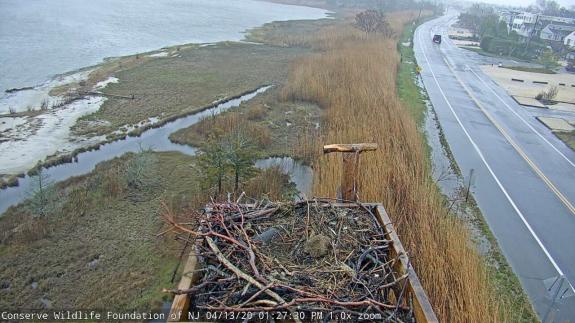 A passing front brought heavy rain and relentless 70+ mph wind gusts to coastal New Jersey on Monday.
A passing front brought heavy rain and relentless 70+ mph wind gusts to coastal New Jersey on Monday.
A cold front brought heavy rain and high winds to New Jersey. Gusts of at least 78mph were observed at coastal locations. Wind speeds this high can easily destroy an osprey nest. One such nest in Oceanville, our old Osprey Cam, had eggs. The female could not remain on the eggs in such high winds, so her clutch of eggs was lost (we are not sure if she had a full clutch). Luckily, it is still early in the nesting season for ospreys, so they can re-nest. At a few other sites we heard that nests had been blown off platforms or structures. This happening early in the season means that the birds will have another chance to re-build. When we see storms like this in summer months, then it means big trouble for ospreys where many nests can fail by losing eggs/young. This severe weather was more damaging to nesting eagles, who have young that are still flightless.
 Female perched in the evening.
Female perched in the evening.
Otherwise, the female stuck around the nest for a while last night. When this happens then it usually means eggs will be laid soon.
April 8
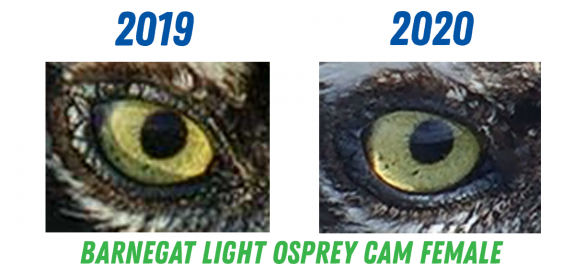 Zoom+ Comparison of the right iris in the 2019-2020 female.
Zoom+ Comparison of the right iris in the 2019-2020 female.
The young male who arrived first at this nest has been defeated by the older, more mature male. We finally confirmed his full band number is 1088-08822. I banded him as a nestling on July 13, 2015 inside Sedge Islands WMA at nest 123-A-042, just 3.15 miles to the north of where he now nests.
 Zoom+ A comparison of 2019-2020 females.
Zoom+ A comparison of 2019-2020 females.
Today I also confirmed that it's the same female as last year (first year of cam) and likely the same as when the nest first became active (2018)! Like mentioned previously, ospreys can be identified by their iris' and feather patterns on their heads, like an avian fingerprint. The female at this nest has some diistinct flecking of brown spots on her right iris, as you can see in the above comparison photos. This is a really neat component of using technology to ID birds.
As you can see the pair is working on the nest a bit to spruce it up and prepare for egg laying. We did observe what looked like successful breeding this past Sunday, but they will mate again to streghten their pair bond. The male been providing prey to her, which is key for their successful nesting attempt.
Last year the female laid the first egg on April 20. Think she'll lay before then? I do. -BW
April 2
Activity at the nest is spreading like wildfire now! This morning before 8am the young (unbanded) male battled with a banded adult male. As you'll see in the video above the banded male won. He has been seen perched on the nest later this morning and there has been no sign of the young male. We shall see what plays out with regards to who wins over the female, and if that female is the same as last year (we need to get some good stills of her head to ID).
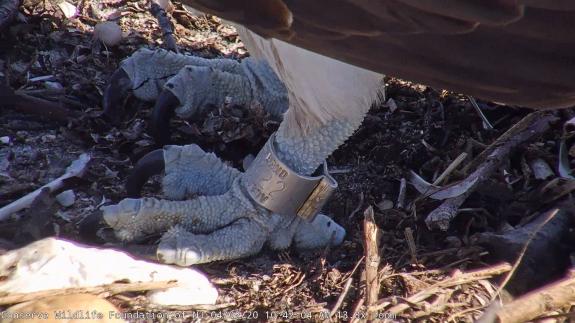 The band on the new adult male reads xxxx-xx822.
The band on the new adult male reads xxxx-xx822.
Otherwise, we mentioned that the new male is banded. Well, so far we've been able to read at least 3 digits of his federal bird band, which is 9 digits long -- xxxx-xx822. This alone tells us that this is NOT the same 12 year old male as last year, whose band ended in 033. A quick search of our banding records revealed at least 18 birds who have a suffix that ends in 822, but we suspect it is one bird who was banded close to Barnegat Light, at Sedge Islands. This is because males return very close to their natal areas to breed as adults and female tend to wander further away. This is likely to prevent inbreeding. The real fascinating component of this is that if the full band # of the male is 1088-08822, then he was banded on the same day as 90/C, a red banded osprey (fed band is: 1088-08825) who was observed on the nest on March 31!! They originated from different nests from inside Sedge Islands WMA. Great observatons using the camera system here to identify birds we've banded.
March 31
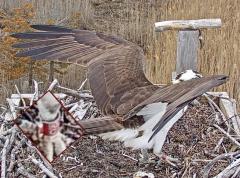 Zoom+ Osprey 90/C lands on the Barnegat Light Osprey Cam at 11:04am on 3/31/20.
Zoom+ Osprey 90/C lands on the Barnegat Light Osprey Cam at 11:04am on 3/31/20.
Well, things are really heating up here! Both birds who have been hanging on the nest over the past few days are new. The old male was banded and had a much more distinctive pale yellow iris. This new male is a young adult with a more orange tinted iris and little experience. He is mantling a lot and being very submissive to the female, who also appears to be new (I still have to get some good snapshots of her head to confirm). The male has made a few (unsuccessful) attempts to mate with this female this morning on the nest.
It is still early, so one from last year could still return and take back their nest. If they don't then this might be an interesting season to watch with a new pair attempting to nest for their first time...
At around 11am this morning a red banded bird landed on the nest long enough to get it on video and review to confirm its ID -- 90/C, who was banded as a nestling near the Spizzle Creek Bird Blind at Island Beach State Park. 90/C was one of three 5 week old nestlings who were banded on July 13, 2015. You can read more about that on the Island Beach Nature Programs Blog.
March 29
Yesterday morning two females landed on the nest - one after another. Neither appears to be the same female as last year. We can ID an individual bird by a couple different methods. One is their leg band (if banded). Another by the plumage on the top of their heads, which is like a fingerprint. The last is their iris, which can have dark pigmentation around their pupil.
A male landed on the nest this morning. If you see a bird on the nest, please post to the interaction page or email me to let me know when and I can pull video to share. BW
March 23
More and more ospreys are returning to their summer breeding grounds. South winds aid in their northward migration in spring. At the osprey cam on Friday, a banded male was observed landing on the nest. He didn't stay long but you can see in the video that he is banded, so could this be our male? It's quite possible, but he hasn't been seen on the nest since. BW
March 3
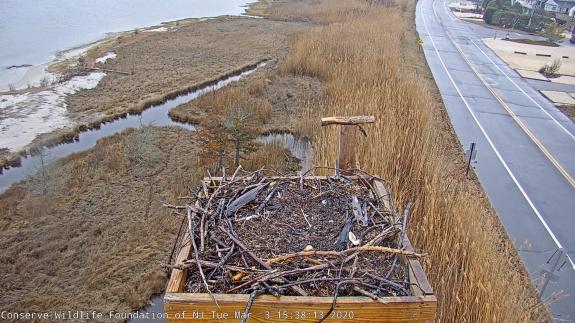 A wet afternoon on March 3.
A wet afternoon on March 3.  Base station at the Osprey Cam.
Base station at the Osprey Cam.
Word on the interwebs is that an osprey was viewed on camera yesterday! I did not see myself and we did not yet have our internal network storage device installed, so we are relying on sightings from our faithful watchers on the report. It is still early for most birds to arrive back, but sightings have been coming in from coastal locations in Viginia, and Maryland. With more south winds, they will help push more spring migrants northward. With a very mild winter it's anything goes at this point. Last year we observed egg laying as early as April 9.
If you happen to catch a glimpse of an osprey on the nest, take a screen shot and hop on over to our interaction page and post it there to share your sighting. BW
Feb 7
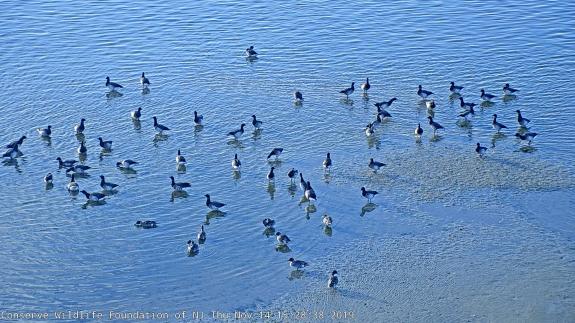 Atlantic brant along the shoreline in Barnegat Light.
Atlantic brant along the shoreline in Barnegat Light.
If you haven't noticed, after popular demand, we decided to keep the Osprey Cam online all winter. While we should re-brand as the "Brant Cam," it is a great time to watch the seasonal shift in winter wildlife and weather. January seemed to fly by and there was little in the form of ice on the bay as opposed to last year, when the bay was frozen solid. It's no surprise as January was the warmest ever recorded worldwide and the 5th warmest in the US. As I type this I received notifications for a severe thunderstorm.
Anyway, ospreys are set to begin to their northward migration in the coming weeks. From now until they begin nesting, we have the big task of completing repairs at nests. This is something that would not be possible without our awesome volunteers! Next week we will release the 2019 NJ Osprey Project Report, so stay tuned for that. -Ben
Find Related Info: Osprey




